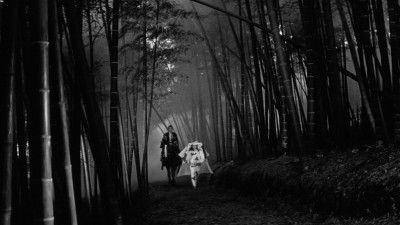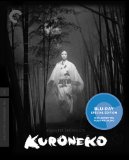| Reviews & Columns |
|
Reviews DVD TV on DVD Blu-ray 4K UHD International DVDs In Theaters Reviews by Studio Video Games Features Collector Series DVDs Easter Egg Database Interviews DVD Talk Radio Feature Articles Columns Anime Talk DVD Savant Horror DVDs The M.O.D. Squad Art House HD Talk Silent DVD
|
DVD Talk Forum |
|
|
| Resources |
|
DVD Price Search Customer Service #'s RCE Info Links |
|
Columns
|
|
|
Kuroneko (Criterion Collection)
It's not as good as Shindo's previous venture into the supernatural, Onibaba ("Witch," 1964), a striking, much more original, even unique work. Nonetheless, Onibaba and Kuroneko otherwise are quite similar. Both revolve around a middle-aged mother and her daughter-in-law, the former in both films played by Nobuko Otowa (Shindo's actress-wife), responding violently to warring samurai infesting their peaceful rural community like a swarm of locusts. (Which they resemble, in Shindo's excellent opening shots.)
Criterion's new Blu-ray version presents a near-flawless presentation of this film, gorgeously photographed by Kiyomi Kuroda, in black-and-white CinemaScope. Extras include a one-hour interview with Shindo, conducted in the mid-1990s (Shindo, now 99 1/2 years old, happily is still with us), a nice video interview with film critic Tadao Sato, and a pristine Japanese trailer, also in high-def.
The movie is set in 12th century Japan (or the 15th-16th century, sources vary). After a young peasant farmer is essentially kidnapped and forced to become a foot soldier, his wife, Shige (Kiwako Taichi), and mother, Yone (Nobuko Otowa), are gang-raped and murdered by marauding samurai thugs, who also casually burn their home to the ground. Aided by the family's black cat, Shige and Yone become vengeful ghost-cats themselves, vowing to drink the blood of all samurai. At this point the film repeatedly - too repeatedly - shows one samurai after another lured from Rashomon (Kyoto's southernmost gate) and into their new, bamboo-infested residence, deep in the grove. (As reader Sergei Hasenecz points out, "The use of the word 'grove' in the Japanese title, as well as the gate from where the samurai are lured, are likely invoking the movie Rashomon, also known as "In a Grove.")
Warlord Raiko Minamoto (Kei Sato) orders one of his best samurai, Gintoki (Kabuki star Kichiemon Nakamura), a war hero after slaying imposing Ainu warrior Sunehiko the Bear (Eiju Kaneda), to likewise slay the ghosts slowly picking off his army of samurai. However, Gintoki turns out to be Yone's son and Shige's husband, and the story moves in a different direction altogether.
Kaidan eiga, including movies about ghost-cats, have long been popular in Japan. Such films were usually released in the late summer, timed with the Bon holiday, when Japanese on summer holiday visit the graves of their ancestors and in turn invite the dead to visit the homes of the living before sending them back into the spirit world at the holiday's end. These kaidan eiga were typically produced by B-picture studios like Shintoho, just as lower-tier companies like Universal and Monogram specialized in horror films in America.
But, occasionally, the more important studios would invest in big-budget adaptations of popular legends. Besides Kobayashi's Kwaidan, director Shiro Toyoda made a classy adaptation of Yotsuya kaidan, the most famous Japanese ghost story, in 1965, in a film starring Tatsuya Nakadai and titled Illusion of Blood for the English-speaking market. Like Kwaidan and Kuroneko, it specifically seemed to be setting its sights on international film festival competitions. And it's important to remember that Japan's early international successes began with films with supernatural elements: Akira Kurosawa's Rashomon (featuring a medium, 1950) and Ugetsu (1953), the latter directed by Kenji Mizoguchi, Shindo's mentor.
Kuroneko's release, alas, was ill-timed. It was entered at the 1968 Cannes Film Festival, but it was cancelled as a result of the wildcat strikes that brought France to a virtual standstill that May.* In Japan the picture was released off-season, in February, headlining a mismatched double-bill supported by a "Shacho" salaryman comedy, Five Gents and a Chinese Merchant. Otowa and cinematographer Kuroda were awarded prizes at the Mainichi Film Concurs, but the picture wasn't the great international success everyone had hoped.
Kuroneko is highly stylized, influenced greatly by traditional Japanese theater and dance. The make-ups, for instance, are singularly unreal in the western sense, but unsettling nevertheless. Otowa glides across the room, moving with a dancer's grace. Indeed, Shindo cuts away to her traditional dancing so frequently that it borders on the comical. The lighting and art direction are as excellent as the cinematography, and there's some especially imaginative use of double-exposures (bamboo, and in one striking shot, a huge sun in the background), composite images that deliberately throw compositions off-balance. Similarly, Hikaru Hayashi's experimental score is nothing less than outstanding, with uniquely and unexpectedly orchestrated cues. Writer Maitland McDonagh is right when she states that it "can be heard as far afield as Dario Argento's 1977 Suspiria."
Shindo, a socialist and born to an upper middle-class family whose farm went belly-up, in his films is always on the side of the peasants, "down-to-earth people who have to live like weeds," while holding all samurai and government officials in utter contempt. In Kuroneko the samurai are as brutal and self-serving as the bandits in Seven Samurai. In one scene Kei Sato's character claims that his samurai class serve peasants as well as the aristocracy, but virtually in the same sentence he goes on to dismiss them as something sub-human undeserving of any rights at all.
Like Shindo's other films (and similar to Imamura's) there's a preoccupation with sex and the risqué notion of Gintoki resuming his sex life with Shige, ghost though she may be. And, as Shindo admitted to Joan Mellen, there's also a Freudian element at play between Gintoki and his mother. These scenes are more self-consciously arty than the more honest and explicit ones in Onibaba, just as scenes of horror seem to have been deliberately fashioned for foreigners drawn to Asian exoticness.
It's still good stuff, but just as Kwaidan was criticized by many Japanese as being too prim and proper, coming in the wake of bankrupted Shintoho's blood-and-thunder ghost pictures and other horror films of the 1950s and early-'60s (such as Nobuo Nakagawa's wacky Woman Vampire, 1959, and the unforgettable Jigoku, 1960), Kuroneko is classy and visually spectacular, and the relationship between Gintoki and the ghost-cat women is intriguing, but in the end Kuroneko is a bit too stately for its own good and not very frightening, though it does sustain an uncanny atmosphere and is exceedingly beautiful throughout.
Video & Audio
Kuroneko was transferred on a Spirit 4K and derived from a new 35mm print struck from the original negative. The results are outstanding, with extreme detail in some shots (all that bamboo and grass coming off particularly well) and excellent contrast throughout, with the blackest of blacks. The mono audio (Japanese only, with optional white English subtitles) is fine, remastered at 24-bit from an optical print. The disc is Region "A" encoded.
Extra Features
Supplements include an hour-long interview with Shindo spanning his entire career, apparently part of an ongoing project by the Directors Guild of Japan. Film critic Tadao Sato appears in a new interview (in HD) in which he provides a good overview of the film, its influences, and place in Japanese cinema history. Finally, an excellent trailer, also in 1080p high-def, is complete with text and English subtitling.
Parting Thoughts
Visually scrumptious with a musical score to match, Kuroneko is a classy kaidan eiga with much to recommend it, and with its superb video transfer and good supplements, comes Highly Recommended.
* Writer Stephen Bowie adds, "I'm not sure that's the most accurate description of what happened at Cannes 1968 -- the festival shut down mainly because the French Cultural Minister fired Henri Langlois, the head of the Cinematheque Francaise, although the strikes and student protests amped up the spirit of rebellion. Several prominent French directors either withdrew their films or resigned from the Jury; it would be interesting to know if Shindo, being a leftist, was in there cheering on the protests and voluntarily withdrew Kuroneko, or if he was fuming at the career setback!"
Stuart Galbraith IV's latest audio commentary, for AnimEigo's Musashi Miyamoto DVD boxed set, is on sale now.
|
| Popular Reviews |
| Sponsored Links |
|
|
| Sponsored Links |
|
|
| Release List | Reviews | Shop | Newsletter | Forum | DVD Giveaways | Blu-Ray | Advertise |
|
Copyright 2024 DVDTalk.com All Rights Reserved. Legal Info, Privacy Policy, Terms of Use,
Manage Preferences,
Your Privacy Choices | |||||||














